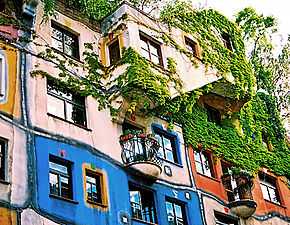Hundertwasserhaus
Coordinates: 48°12′26″N 16°23′39″E / 48.20722°N 16.39417°E

The Hundertwasserhaus is an apartment house in Vienna, Austria, built after the idea and concept of Austrian artist Friedensreich Hundertwasser with architect Joseph Krawina as a co-author. This expressionist landmark of Vienna is located in the Landstraße district on the corner of Kegelgasse and Löwengasse.
Hundertwasser and architecture
Friedensreich Hundertwasser started out as a painter. Since the early 1950s, however, he increasingly became focused on architecture, writing and reading in public .’ advocating natural forms of decay) In 1972, he had his first architectural models made for the TV-show ‘Wünsch dir was', in order to demonstrate his ideas on forested roofs, "tree tenants" and the "window right" of every tenant to embellish the facade around his windows. In these models Hundertwasser also developed new architectural shapes, such as the "eye-slit" house and the "high-rise meadow house"[1]
In lectures at academies and before architectural associations, Hundertwasser elucidated his concerns regarding an architecture in harmony with nature and man. In a letter dated November 30, 1977 to the mayor of Vienna, Leopold Gratz, the federal chancellor at the time, Bruno Kreisky, suggested that Hundertwasser be given the opportunity to realize his ideas in the field of architecture by allowing him to build a housing project, whereupon Leopold Gratz, in a letter of December 15, 1977, invited Hundertwasser to create an apartment building according to his own ideas.[2] The search for a suitable building plot took several years. Because Hundertwasser was not an architect he asked the City of Vienna to provide a professional architect willing to transpose his concepts into architectural drawings. To this end, architect Josef Krawina was invited to join the artist and to help him to put his ideas into practice.
Conflict and cooperation
In August and September 1979, architect Krawina presented to Hundertwasser his preliminary drawings and a Styrofoam model. Hundertwasser was shocked and rejected them as representing exactly the leveling, straight-lined modular grid against which he had consistently fought.[3] As his model of the “Terrace House” for Eurovision showed, he had already conceptualized a quite different type of house.[4] Hundertwasser succeeded in convincing the City of Vienna of the validity of his concept of a forested roof terrace house. However, architect Krawina continued to express skepticism towards these ideas and this prompted the artist to write to the director of the Vienna Magistrate Department 19, architect Kolowrath, asking that architect Krawina be replaced in order that his own ideas be realized. Krawina indeed left the project and architect Peter Pelikan, an employee of the City's Magistratsabteilung 19, took over the planning. Architect Pelikan became Hundertwasser’s long-term partner, working with him on numerous other building projects.
In the end the house was built between 1983 and 1985 according to the ideas and concepts of Hundertwasser with architect Univ.-Prof. Joseph Krawina as a co-author and architect Peter Pelikan as a planner. It features undulating floors ("an uneven floor is a divine melody to the feet"[5]), a roof covered with earth and grass, and large trees growing from inside the rooms, with limbs extending from windows. Hundertwasser took no payment for the design of the house, declaring that it was worth it, to prevent something ugly from going up in its place.
Within the house there are 52 apartments, four offices, 16 private terraces and three communal terraces, and a total of 250 trees and bushes. The Hundertwasser House is one of Vienna's most visited buildings and has become part of Austria's cultural heritage.[6]
Court decision
In 2001, twenty years after architect Krawina’s exit from the project, the firm H.B. Medienvertriebsgesellschaft mbH under its business manager Harald Böhm encouraged architect Krawina to legally substantiate his claim as co-creator of the “Hundertwasser House.” On March 11, 2010, after eight years of litigation, Austria's Oberster Gerichtshof [Supreme Court of Justice] ruled Josef Krawina along with Friedensreich Hundertwasser, to be co-creators of the house with the effect that it is now forbidden for the Hundertwasser Non-Profit Foundation to disseminate any illustration or replica of the house without acknowledging Krawina as co-creator. According to the ruling, Hundertwasser was the sole spiritual creator (German: Geistiger Schöpfer) of the building, however, Krawina must be recognized as a co-creator of equal standing and be paid an equal share in royalty receipts.[7]
Pictures
-

Hundertwasser, Vienna, Austria
-

Hundertwasser, Vienna, Austria
-

Hundertwasser, Vienna, Austria
-

Hundertwasser, Vienna, Austria
References
- ↑ See: Hundertwasser Architecture, For a More Humane Architecture in Harmony with Nature, Cologne: Taschen, 2007, p. 70
- ↑ Both letters published in: Das Hundertwasser Haus, Vienna: ÖBV and Compressverlag, 1985, pp. 160, 161)
- ↑ Images in: Das Hundertwasser Haus, Vienna: ÖBV and Compress Verlag, 1985, pp. 166-170
- ↑ Hundertwasser Architecture, For a more human architecture in harmony with nature, Cologne: Taschen, 2007, p. 73
- ↑ Brikcius, Eugen (1992). Die entzauberte Idylle: Österreichische Spaziergänge (in German). p. 636. ISBN 978-3-7001-3261-5.
- ↑ Stallein, Rudi (2002-01-17). "Hundertwasser-Bauwerke: Sehenswürdigkeiten in einem Rausch aus Farben und Formen" (in German). FAZ.NET. Retrieved 2008-11-09.
- ↑ OGH: Hundertwasser-Haus ist auch von Josef Krawina (in German). Die Presse. May 16, 2010.
External links
| Wikimedia Commons has media related to Hundertwasserhaus. |